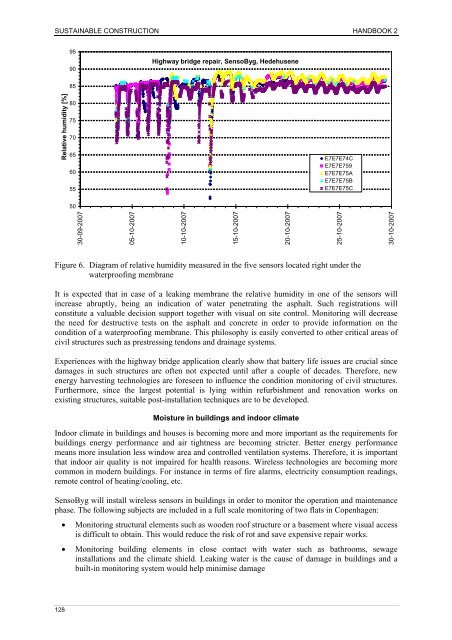Industrialised, Integrated, Intelligent sustainable Construction - I3con
Industrialised, Integrated, Intelligent sustainable Construction - I3con
Industrialised, Integrated, Intelligent sustainable Construction - I3con
You also want an ePaper? Increase the reach of your titles
YUMPU automatically turns print PDFs into web optimized ePapers that Google loves.
SUSTAINABLE CONSTRUCTION HANDBOOK 2<br />
Relative humidity [%]<br />
128<br />
95<br />
90<br />
85<br />
80<br />
75<br />
70<br />
65<br />
60<br />
55<br />
50<br />
30-09-2007<br />
05-10-2007<br />
Highway bridge repair, SensoByg, Hedehusene<br />
10-10-2007<br />
15-10-2007<br />
20-10-2007<br />
E7E7E74C<br />
E7E7E759<br />
E7E7E75A<br />
E7E7E75B<br />
E7E7E75C<br />
Figure 6. Diagram of relative humidity measured in the five sensors located right under the<br />
waterproofing membrane<br />
It is expected that in case of a leaking membrane the relative humidity in one of the sensors will<br />
increase abruptly, being an indication of water penetrating the asphalt. Such registrations will<br />
constitute a valuable decision support together with visual on site control. Monitoring will decrease<br />
the need for destructive tests on the asphalt and concrete in order to provide information on the<br />
condition of a waterproofing membrane. This philosophy is easily converted to other critical areas of<br />
civil structures such as prestressing tendons and drainage systems.<br />
Experiences with the highway bridge application clearly show that battery life issues are crucial since<br />
damages in such structures are often not expected until after a couple of decades. Therefore, new<br />
energy harvesting technologies are foreseen to influence the condition monitoring of civil structures.<br />
Furthermore, since the largest potential is lying within refurbishment and renovation works on<br />
existing structures, suitable post-installation techniques are to be developed.<br />
Moisture in buildings and indoor climate<br />
Indoor climate in buildings and houses is becoming more and more important as the requirements for<br />
buildings energy performance and air tightness are becoming stricter. Better energy performance<br />
means more insulation less window area and controlled ventilation systems. Therefore, it is important<br />
that indoor air quality is not impaired for health reasons. Wireless technologies are becoming more<br />
common in modern buildings. For instance in terms of fire alarms, electricity consumption readings,<br />
remote control of heating/cooling, etc.<br />
SensoByg will install wireless sensors in buildings in order to monitor the operation and maintenance<br />
phase. The following subjects are included in a full scale monitoring of two flats in Copenhagen:<br />
• Monitoring structural elements such as wooden roof structure or a basement where visual access<br />
is difficult to obtain. This would reduce the risk of rot and save expensive repair works.<br />
• Monitoring building elements in close contact with water such as bathrooms, sewage<br />
installations and the climate shield. Leaking water is the cause of damage in buildings and a<br />
built-in monitoring system would help minimise damage<br />
25-10-2007<br />
30-10-2007






